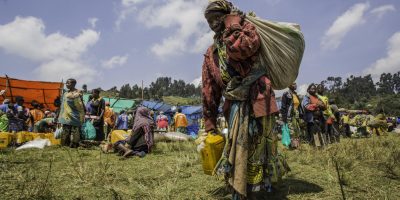More People Displaced Inside Their Own Countries than Ever Before

The number of people living in internal displacement worldwide as of the end of 2018 is the highest it has ever been, according to the Global Report on Internal Displacement, launched today at the United Nations in Geneva. This is an increase of more than a million since the end of 2017 and two-thirds more than the global number of refugees.
The record figure is the result of years of cyclical and protracted displacement, and high levels of new displacement between January and December 2018. IDMC recorded 28 million new internal displacements associated with conflict, generalised violence and disasters in 2018.
Ongoing conflict in the Democratic Republic of the Congo and Syria, and a rise in intercommunal tensions in Ethiopia, Cameroon and Nigeria’s Middle Belt region triggered most of the 10.8 million new displacements linked to conflict and violence. Internally displaced people (IDPs) who tried to return to their homes in Iraq, Nigeria and Syria during the year found their property destroyed, infrastructure damaged and basic services non-existent.
“This year’s report is a sad reminder of the recurrence of displacement, and of the severity and urgency of IDPs’ needs. Many of the same factors that drove people from their homes now prevent them from returning or finding solutions in the places they have settled,” said Alexandra Bilak, IDMC’s director.
Extreme weather events were responsible for the majority of the 17.2 million new displacements associated with disasters in 2018. Tropical cyclones and monsoon floods led to mass displacement in the Philippines, China and India, mostly in the form of evacuations. California suffered the most destructive wildfires in its history, which displaced hundreds of thousands of people.
A number of countries were affected by both conflict and disasters. Drought in Afghanistan triggered more displacement than the country’s armed conflict, and the crisis in north-eastern Nigeria was aggravated by flooding that affected 80 per cent of the country.
“The findings of this report are a wake-up call to world leaders. Millions of people forced to flee their homes last year are being failed by ineffective national governance and insufficient international diplomacy. Because they haven’t crossed a border, they receive pitiful global attention,” said Jan Egeland, Secretary General of the Norwegian Refugee Council. “All displaced people have a right to protection and the international community has a duty to ensure it.”
The report shows that internal displacement is an increasingly urban phenomenon. Warfare in cities such as Dara’a in Syria, Hodeidah in Yemen and Tripoli in Libya accounted for much of the displacement recorded in the Middle East in 2018. Urban centres such as Dhaka in Bangladesh are also the preferred destination for many people fleeing the effects of climate change.
Such influxes present great challenges for cities and can aggravate existing risk factors. People who fled fighting in rural areas of Afghanistan and Somalia faced abject poverty, tenure insecurity and onward displacement from flooding and evictions in Kabul and Mogadishu.
New ways of dealing with the issue are emerging in cities from Medellín in Colombia to Mosul in Iraq, where local governments and communities have taken the lead.
“The fact that cities have become sanctuary to more and more internally displaced people represents a challenge for municipal authorities, but also an opportunity. Leveraging the positive role that local government can play in finding solutions to displacement will be key to addressing this challenge in the future,” said Alexandra Bilak.
*
Note to readers: please click the share buttons below. Forward this article to your email lists. Crosspost on your blog site, internet forums. etc.
Featured image: Displaced families receive household items in North Kivu province, Democratic Republic of the Congo. Photo: Norwegian Refugee Council/Martin Lukongo.

